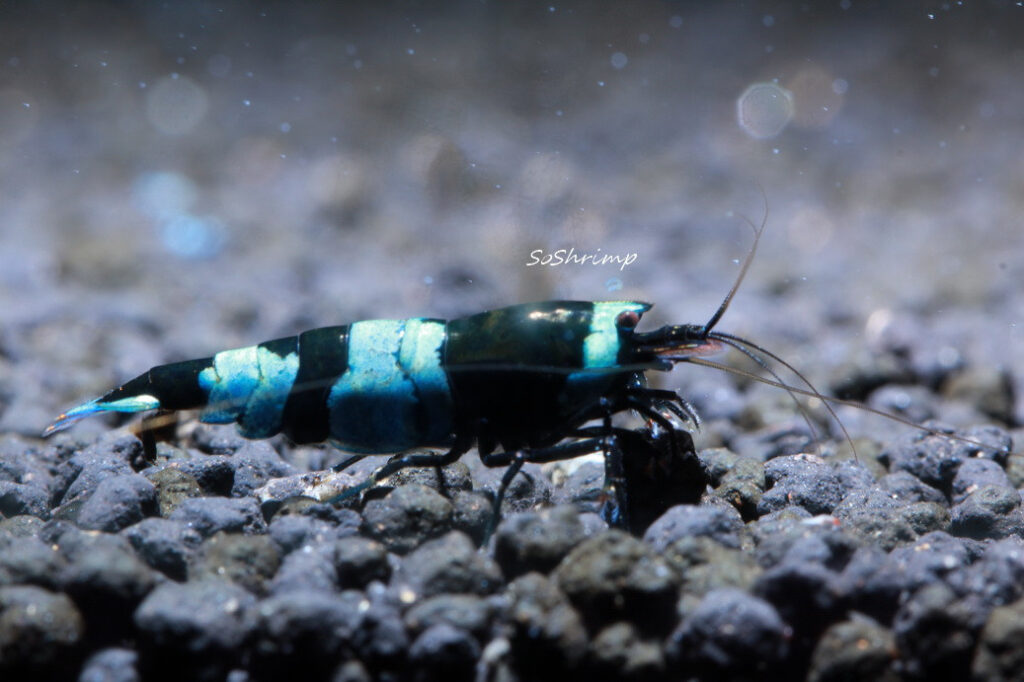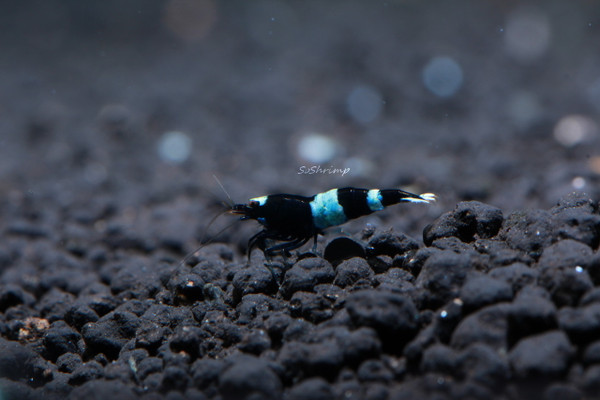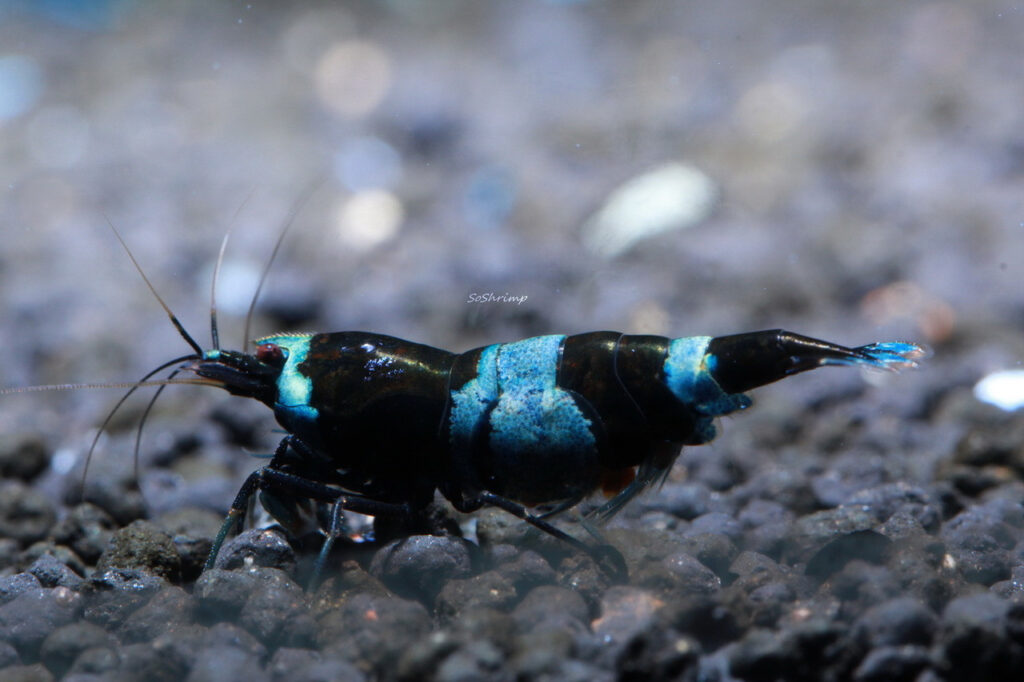Brief Description of Caridina Black Shadow Bee Shrimp Appearance
Caridina Black Shadow Bee Shrimp, from the Taiwan Bee shrimp family, are renowned for their striking black and blue hues, are a captivating addition to any freshwater aquarium. Their unique and contrasting patterns make them highly sought after by shrimp enthusiasts and aquarists.
Scientific Name and Classification
The Caridina Black Shadow Bee Shrimp belongs to the Caridina genus within the Atyidae family. Its scientific name is Caridina cantonensis, with various selective breeding efforts resulting in this distinctive black variant. Other common names include Shadow panda, blue shadow, blue panda.
Origin and Natural Habitat
Originating from the freshwater streams of Southern China, particularly in the Guangdong and Hong Kong regions, bee shrimp thrive in clean, well-oxygenated waters with a slow current and abundant plant life. Their natural habitat provides a stable environment with soft, slightly acidic water conditions.
Physical Appearance, Size, and Lifespan
Caridina Black Shadow Bee Shrimp typically exhibit a deep black coloration on the carapace, contrasted by deep blue colors on the body. They are relatively small, reaching about 1 to 1.25 inches (2.5 to 3.2 cm) in length. With proper care, their lifespan ranges from 1.5 to 2 years, though some individuals may live longer in optimal conditions. Shadow bees are selective bred from and blue bolt and black panda shrimp. They can be safely kept with other types of Taiwan Bee.

History of Caridina Black Shadow Bee Shrimp
Development Through Selective Breeding
The stunning appearance of Caridina Black Shadow Bee Shrimp is the result of extensive selective breeding. Aquarists have meticulously bred these shrimp to enhance their black coloration and distinct patterns, creating a visually striking variant from the wild-type Caridina cantonensis.
Relation to Crystal Red Shrimp
Caridina Black Shadow Bee Shrimp are closely related to the Crystal Red Shrimp, another popular variant of Caridina cantonensis. Both shrimp come from Taiwan Bee shrimp, and share similar care requirements and physical traits, but the Black Shadow variant stands out due to its unique color pattern.
Popularity in the Aquarium Hobby
Since their introduction into the aquarium hobby, Caridina Black Shadow Bee Shrimp have gained immense popularity among shrimp enthusiasts. Their striking appearance and relatively easy care requirements make them a favorite choice for both novice and experienced aquarists.
Caridina Black Shadow Bee Shrimp Care and Ideal Water Parameters
To ensure the health and well-being of Caridina Black Shadow Bee Shrimp, maintaining the following water parameters is crucial:
- Total Dissolved Solids (TDS): 100-120 ppm
- pH: 5.4-6.2
- General Hardness (GH): 4-5
- Carbonate Hardness (KH): 0-1
- Temperature: 60-72°F (15-22°C)
These parameters mimic their natural habitat, providing a stable and conducive environment for their growth and reproduction. Regular monitoring and maintenance of these water conditions are essential for keeping Caridina Black Shadow Bee Shrimp healthy and vibrant.

Setting Up a Successful Caridina Black Shadow Bee Shrimp
Tank Size Recommendations
For Caridina Black Shadow Bee Shrimp, a tank starts at 10 gallons (38 liters), and minimum of 5 gallons (19 liters). Larger tanks provide more stable water parameters, which is crucial for maintaining the delicate balance needed for these shrimp to thrive. Smaller tanks can be used but require more frequent monitoring and maintenance.
Filtration Options
Sponge filters are the preferred choice for Caridina shrimp tanks. They provide gentle filtration that does not create strong currents, which can stress the shrimp. Additionally, sponge filters offer a surface for beneficial bacteria to colonize, contributing to the biological filtration of the tank.
Substrate Choices
Choosing the right substrate is essential for maintaining the appropriate water parameters. Active substrates, such as those specifically designed for shrimp tanks, help to buffer the water and maintain a stable pH level. These substrates also support the growth of biofilm, which the shrimp graze on.
Importance of Hiding Places and Plants
Hiding places and plants are vital in a Caridina Black Shadow Bee Shrimp tank. Plants like mosses, ferns, and floating plants provide cover and additional surfaces for biofilm growth. Shrimp also appreciate hiding spots, which can be created using decorations like driftwood, rocks, and shrimp tubes. These features help reduce stress and provide a more natural environment.
Acclimation Process
Acclimating Caridina Black Shadow Bee Shrimp to their new environment is crucial for their survival. The drip acclimation method is recommended. Start by placing the shrimp in a container with the water they came in, then slowly drip tank water into the container over a period of 1-2 hours. This gradual process helps them adjust to the new water parameters without shock.

Diet and Feeding
Natural Feeding Habits
In their natural habitat, Caridina Black Shadow Bee Shrimp feed on biofilm, algae, and decaying plant matter. They are omnivorous scavengers, constantly grazing on available surfaces for food.
Recommended Commercial Foods
A variety of high-quality commercial shrimp foods are available that provide balanced nutrition. Pellets and granules specifically formulated for Caridina shrimp are ideal. Look for products that contain a mix of proteins, minerals, and plant matter to ensure a well-rounded diet.
Supplemental Foods
Supplemental foods can enhance the diet of your Caridina Black Shadow Bee Shrimp. Fresh vegetables such as blanched zucchini, spinach, and cucumber are excellent choices. Additionally, dried leaves like Indian almond leaves (catappa) and oak leaves release beneficial tannins and provide an additional food source as they decompose.
Feeding Frequency and Amount
Feed 2-3 times a week, an amount that the shrimp can consume within 1-2 hours. Avoid overfeeding to maintain water quality and prevent food from fouling the tank.
Understanding Caridina Black Shadow Bee Shrimp
Basic Principles of Caridina Black Shadow Bee Shrimp Grading
Grading Caridina Black Shadow Bee Shrimp involves assessing their color intensity, pattern, and overall appearance. Higher-grade shrimp exhibit more vibrant colors and distinct, well-defined patterns. The grading system helps breeders and hobbyists identify and select the best specimens for breeding and sale.
Importance of Grading in Breeding and Sales
Grading is crucial in the breeding and sale of Caridina Black Shadow Bee Shrimp. High-grade shrimp fetch higher prices and are more desirable among enthusiasts. By selectively breeding high-grade individuals, breeders can enhance desirable traits and produce superior quality shrimp.
Color Grading
Description of Different Color Grades
Caridina Black Shadow Bee Shrimp are graded based on the intensity and uniformity of their color. The grading system typically includes:
- G3: These shrimp have lighter, less intense colors with more transparent areas on their bodies.
- G2: Mid-grade shrimp show more solid and consistent colors but may still have some lighter or transparent patches.
- G1: High-grade shrimp exhibit deep, vibrant colors with minimal transparency. The colors are solid and uniformly distributed.
- G0: Competition grade shrimp display the most intense and saturated colors with a flawless, uniform appearance, making them highly prized among breeders and collectors.
Factors Affecting Color Intensity
Several factors influence the color intensity of Caridina Black Shadow Bee Shrimp:
- Genetics: High-quality breeding stock produces shrimp with better color and pattern consistency.
- Diet: A nutritious diet rich in carotenoids and other color-enhancing nutrients helps maintain vibrant colors.
- Water Parameters: Stable, optimal water conditions contribute to the overall health and coloration of the shrimp.
- Stress Levels: Minimizing stress by providing adequate hiding places and maintaining stable environmental conditions helps enhance and preserve their coloration.
Pattern Grading
Intro to Types of Patterns
Caridina Black Shadow Bee Shrimp exhibit various patterns, each with its own unique appeal:
- No Entry: Shrimp with a solid black body and no other markings.
- Hinomaru: Shrimp with a solid black body and a single, round white spot on the head.
- Mosura: Shrimp with extensive white areas on the body, creating a stark contrast with the black coloration.
Rarity and Value of Different Patterns
The rarity and value of these patterns can vary significantly:
- No Entry: Common but still appreciated for its simplicity and solid coloration.
- Hinomaru: More desirable due to the unique and distinct white spot, making it moderately rare.
- Mosura: Highly prized for its extensive white patterning, making it one of the rarer and more valuable patterns.
Breeding Caridina Black Shadow Bee Shrimp
Breeding Setup Requirements
To successfully breed Caridina Black Shadow Bee Shrimp, you’ll need a well-maintained breeding setup:
- Tank Size: A minimum of 10 gallons to provide adequate space and stable water parameters.
- Filtration: Sponge filters to ensure gentle filtration and biological stability.
- Substrate: Active substrates to help maintain stable pH and provide a surface for biofilm growth.
- Plants and Hiding Places: Mosses, ferns, and other plants to offer cover and additional grazing surfaces.
Mating Behavior
Caridina Black Shadow Bee Shrimp exhibit specific mating behaviors:
- Molting: Females are receptive to mating shortly after molting. Males detect pheromones released by the molting female and become more active in searching for a mate.
- Mating: Once a male finds a receptive female, mating occurs quickly, often lasting only a few seconds.
Egg Development and Hatching
After successful mating, the female carries eggs under her abdomen, known as “berried” shrimp:
- Egg Development: The eggs develop over a period of 3-4 weeks, during which the female fans them to ensure proper aeration and prevent fungal growth.
- Hatching: The eggs hatch into tiny, fully formed shrimplets that resemble miniature adults.
Care for Shrimplets
Proper care for the newly hatched shrimplets is crucial for their survival:
- Feeding: Provide a diet rich in biofilm, powdered shrimp food, and finely crushed commercial shrimp pellets.
- Water Quality: Maintain pristine water conditions with regular monitoring and water changes to prevent ammonia and nitrite spikes.
- Protection: Ensure plenty of hiding places to protect the shrimplets from potential threats and to reduce stress.
These steps will help ensure the successful breeding and raising of Caridina Black Shadow Bee Shrimp, contributing to a thriving shrimp colony.
Common Health Issues and Treatments
Signs of Stress or Illness
Caridina Black Shadow Bee Shrimp can exhibit several signs of stress or illness, including:
- Lethargy: Shrimp becoming less active or spending extended periods hiding.
- Loss of Appetite: Shrimp not eating or showing disinterest in food.
- Discoloration: Fading or loss of their characteristic black coloration.
- Erratic Swimming: Sudden, jerky movements or swimming in circles.
- Molting Issues: Difficulty in molting, incomplete molts, or prolonged molting periods.
Common Diseases and Parasites
Some common diseases and parasites that affect Caridina Black Shadow Bee Shrimp include:
- Bacterial Infections: Symptoms include lethargy, loss of color, and white patches on the exoskeleton.
- Fungal Infections: Characterized by cotton-like growths on the body or legs.
- Vorticella: A parasitic protozoan that appears as white fuzz on the shrimp’s body.
- Planaria: Flatworms that can prey on shrimp, especially vulnerable juveniles.
Prevention and Treatment Options
Effective prevention and treatment strategies include:
- Maintaining Water Quality: Regular water changes, monitoring parameters, and avoiding overfeeding to prevent ammonia and nitrite spikes.
- Quarantine New Shrimp: Isolate new arrivals for 2-4 weeks to prevent the introduction of diseases.
- Use of Antibacterial and Antifungal Treatments: Medications like aquarium salt, commercial antibacterial, and antifungal treatments can be used, but always follow dosage instructions carefully.
- Physical Removal: For parasites like planaria, manual removal, and using traps can be effective.
Compatible Tank Mates
Suitable Shrimp Species
Caridina Black Shadow Bee Shrimp can be kept with other Caridina species that share similar water parameter requirements, such as:
- Crystal Red Shrimp (Caridina cantonensis): They share similar care requirements and can coexist peacefully.
- Taiwan Bee Shrimp: Other variants like Blue Bolt and Red Wine shrimp can be compatible.
Compatible Fish Species
Certain small, non-aggressive fish species can be compatible with Caridina Black Shadow Bee Shrimp, including:
- Otocinclus Catfish: Small and peaceful, they are excellent algae eaters.
- Small Rasboras: Species like Chili Rasboras are non-threatening to shrimp.
- Endler’s Livebearers: These small, colorful fish are generally shrimp-safe.
Species to Avoid
Avoid keeping Caridina Black Shadow Bee Shrimp with aggressive or predatory species, such as:
- Large Cichlids: They can easily prey on shrimp.
- Betta Fish: Known for their aggressive nature, they may harm or eat shrimp.
- Large Catfish: Species like Plecos can pose a threat to shrimp.
FAQs
Can Caridina Black Shadow Bee Shrimp be kept with Crystal Red Shrimp?
Yes, Caridina Black Shadow Bee Shrimp can be kept with Crystal Red Shrimp as they share similar water parameter requirements and temperaments.
Can Caridina Black Shadow Bee Shrimp be kept with fish?
Yes, Caridina Black Shadow Bee Shrimp can be kept with small, non-aggressive fish species like Otocinclus catfish, small Rasboras, and Endler’s Livebearers.
*No fish are not recommended in a breeding colony.
How long do Caridina Black Shadow Bee Shrimp live?
Caridina Black Shadow Bee Shrimp typically live for 1.5 to 2 years with proper care, although some may live longer under optimal conditions.
How often do Caridina Black Shadow Bee Shrimp molt?
Caridina Black Shadow Bee Shrimp molt approximately every 3-4 weeks, depending on their age, diet, and environmental conditions.
What causes Caridina Black Shadow Bee Shrimp to lose color?
Color loss in Caridina Black Shadow Bee Shrimp can be caused by stress, poor water quality, inadequate diet, or illness. Ensuring stable water parameters and a nutritious diet can help maintain their vibrant coloration.
Buying Guide
When purchasing Caridina Black Shadow Bee Shrimp, it’s essential to ensure they meet specific criteria to thrive in your aquarium:
- How to spot healthy shrimp: Look for active shrimp with clear, vibrant black coloration and distinct white Shadow Bee markings. Ensure there are no signs of disease or injury.
- Selecting the best specimens: Choose shrimp that exhibit prominent black coloration with well-defined white patches characteristic of the Shadow Bee pattern.
- Reputable sources for purchasing Caridina Black Shadow Bee Shrimp: Trustworthy breeders and specialized shrimp stores often provide healthier specimens and detailed lineage information. Opt for reputable lineages. For a breeding colony, start with purebred or near purebred lineages to ensure consistent offspring and predictable gene inheritance, free from other variant genes.
- Shipping considerations: Opt for sellers who offer reliable shipping methods, including insulated packaging and temperature control, to minimize stress during transit.
Advanced Caridina Black Shadow Bee Shrimp Keeping For advanced enthusiasts interested in further developing their expertise with Caridina Black Shadow Bee Shrimp:
- Selective breeding techniques: Focus on breeding individuals that enhance the intensity and clarity of the black coloration and white markings typical of Shadow Bee shrimp.
- Creating unique color morphs: Experiment with selective breeding to develop new variations or intensify existing Shadow Bee patterns.
- Participating in shrimp competitions: Engage in local or online shrimp competitions to showcase breeding achievements and exchange knowledge with other dedicated shrimp keepers.
Caridina Black Shadow Bee Shrimp are a captivating addition to any aquarium, known for their striking black coloration and intricate patterns. With proper care, they can thrive and even reproduce, providing endless fascination for both novice and experienced shrimp keepers. By understanding their specific needs, from ideal water parameters to selective breeding techniques, you can successfully maintain and even enhance the beauty of these remarkable creatures. We encourage you to explore the world of Caridina Black Shadow Bee Shrimp and enjoy the rewarding experience of keeping these stunning shrimp.









